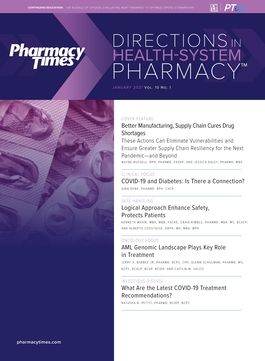Publication
Article
Pharmacy Practice in Focus: Health Systems
Use Proper Procedures When Handling Hazardous Agents
Author(s):
Panel of experts discusses alert systems, PPE, and surface contamination as methods for minimizing exposure to dispensing pharmacists
With a national survey of nurses finding that more than 50% have been exposed to hazardous agents, proper education and safety procedures about handling these agents is essential. In a recent Directions in Oncology Pharmacy® Practice Pearls video, a panel of experts discussed potential harmful effects and best practices for handling hazardous agents.
Health care workers risk exposure to hazardous agents during receipt, transport, storage, compounding, distribution, administration, and disposal of these substances, said moderator Jeffrey Lombardo, PharmD, BCOP, director of pharmacy business development at Catholic Health in Buffalo, New York.
Furthermore, many exposures occur in situations without monitoring requirements, making it necessary to preemptively establish best practices, he said.
The National Institute for Occupational Safety and Health and former researcher Tom Connor, PhD, facilitated a larger understanding of these risks, with publications beginning in 1981, according to panelist Christine Roussel, PharmD, director of pharmacy at Doylestown Health in Pennsylvania.
The definition of a hazardous drug (HD) was established by the American Society of Health-System Pharmacists in 1999, she said.
This definition includes carcinogenic agents; genotoxic agents, which can damage DNA; teratogenic agents, which can harm a fetus; drugs with reproductive toxicity; drugs that are organ toxic at low doses; and any drugs that are structurally similar.
“Hazardous drug handling has really evolved, and we’ve known about the risks for a long time,” Roussel said. “But it’s only been within the last 3 to 5 years that really all of these guidelines and all of these recommendations are now consistent with each other.”
One potential solution for health systems may be to build alerts into their electronic medical records, alerting health care workers when anything on the HD list is ordered in the health system.
With this system, oncology pharmacists and nurses are alerted, allowing them to reach out to the unit where the medication was ordered to ensure that proper procedures are in place, said panelist MiKaela Olsen, MS, APRN-CNS, AOCNS, oncology and hematology clinical nurse specialist at the Sidney Kimmel Comprehensive Cancer Center in Baltimore, Maryland.
Proper labeling is also essential to ensure that health care workers know whether to wear gloves or take other precautions before touching a container, intravenous (IV) bag, or medication bottle.
“The biggest issue I worry about [with hazardous agents] is contamination on the outside of packaging, of everything from unit dose medications to the IV medications that we compound,” Roussel said. “Whatever is inside is on the outside, and the biggest source of contamination is surface contamination and exposure.”
Lombardo agreed, saying that proper handling procedures are important even in health systems that do not have best practices fully implemented.
Because of the opportunities for chronic, long-term exposure among health care workers, dermal exposure via surface contamination could have many risks, including infertility, skin rashes, and various cancers.
“When you look at health care workers, we have more chromosomal damage—so, damage to our DNA—than other people who are walking around in this country,” Roussel said.
“And those health care workers who work with hazardous drugs have more genetic damage than matched controls who don’t work with hazardous drugs,” she said. “So, it is a huge risk, even if we look at populations as a whole.”
Safety precautions include use of appropriate gloves, proper gowning, and respirators, the panelists said.
Despite research on the importance of such measures, it may be difficult for some health systems to implement such practices, Lombardo said.
Consequently, alternative duty systems are essential to ensure that workers’ concerns about exposure are addressed, the panelists said.
In a chemotherapy infusion clinic, for example, Olsen said that they have found triage roles, positions in the ambulatory clinical evaluation program, and roles in the hematology clinic where nurses administer blood and platelets.
Workers should be able to choose whether they handle HDs and have other options if they think that the risks are too high, she said.
“There are ways to move and shift people so that they can avoid handling hazardous drugs for a time, but I really believe it’s the person’s choice,” Olsen said.
Finally, the panelists discussed risks involved in compounding hazardous agents.
Once the compounded substance is packaged, it becomes impossible to see mistakes or miscalculations, Roussel said.
To avoid these issues, bar code scanners and safety systems become essential, especially during busy hours, when it is easier to make an error, Olsen said.
“Manpower is always time, and the patients all come at once,” Roussel said. “So especially around lunchtime, by the time we get there, I see the value from the workflow of my staff, the amount of time my staff takes, and their exposure. But also, I think about associate safety, and I think about how [this] could possibly save a patient’s life one day.”

Newsletter
Stay informed on drug updates, treatment guidelines, and pharmacy practice trends—subscribe to Pharmacy Times for weekly clinical insights.






